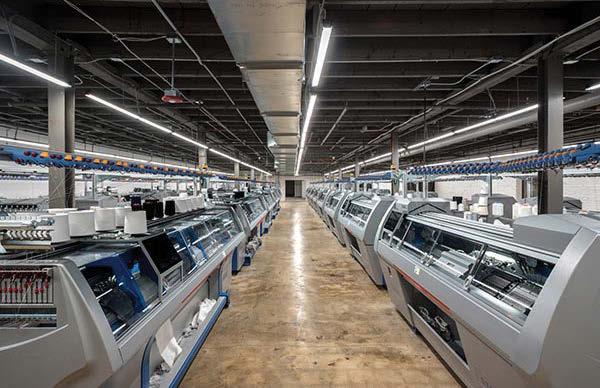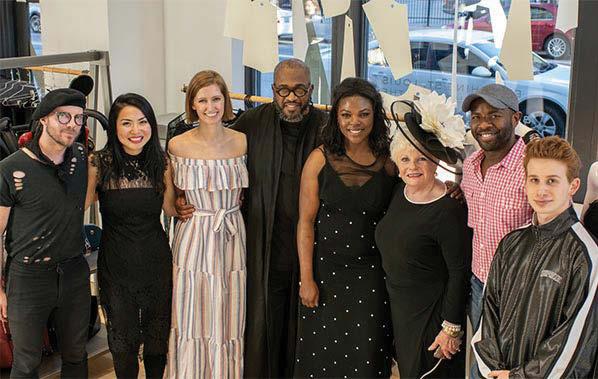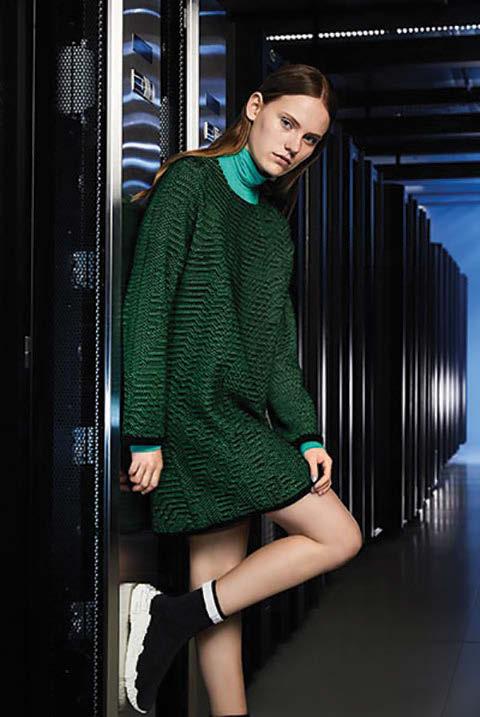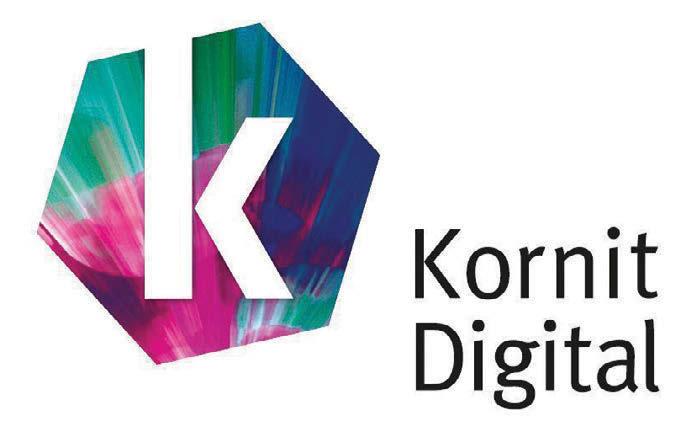
14 minute read
BRINGING FASHION BACK TO ST. LOUIS
BRINGING FASHION
BACK TO ST. LOUIS
The St. Louis Fashion Fund is thriving.
By Cary Sherburne
The global pandemic is accelerating needed change in the textiles and apparel supply chain, but it’s also putting the brakes on many of the initiatives that were helping to drive change forward. But there is good news coming out of the fashion front from St. Louis, where the Saint Louis Fashion Fund closed down briefly early in the pandemic but is now back at work helping to reestablish St. Louis as a fashion hub, a position it held only second to New York from the turn of the 20th century until post-World War II. We spoke with one of its founders, Susan Sherman, and Jon Lewis, CEO of Evolution St. Louis, a high-tech knitting facility the Fund has attracted to St. Louis, to learn more.
WhatTheyThink: Susan, can you start by giving us some background on the Saint Louis Fashion Fund?
Susan Sherman: The Saint Louis Fashion Fund was founded about seven years ago to support emerging designers and promote fashion education and outreach in St. Louis.

A lot of the younger generation was not familiar with the history of St. Louis as a fashion hub, and among other things, we wanted to change that. We were formerly located on Washington Avenue in downtown St. Louis (the Fund will be moving to a new location in the city soon), which used to be known as Shoe Street U.S.A.
WTT: Talk a little bit about how you have worked to support emerging designers.
SS: We have had two cohorts of designers go through a program, where we provided them with a showroom, a cutand-sew facility and office space. We also gave them stipends and connected them with mentors, and helped them (Above) First St. make connections Louis Fashion Fund with fashion centers in New Designer Cohort (Left) Susan Sherman, York, Los Angeles, etc. St. Louis Fashion Fund WTT: Where did the Co-Founder attendees come from?
SS: The first group came as an essential business during from all over the U.S. We the pandemic, and we manuworked with a company in factured a lot of masks as the New York called Launch pandemic heated up. Our knitCollective that did all of the Second Fashion Fund Designer Cohort ting machines can knit masks business-related learning with as one piece, and because of the them. And then we had a host of mentors in St. innovative yarns we use, they have a lot of antimiLouis that worked with them on an as-needed crobial properties. We didn’t anticipate buying all basis. In our 7,500-square-foot facility, we had a these high-tech machines to make masks; it’s kind 2,500-square-foot showroom where they were of like driving a Ferrari to the grocery store to get really able to get to know a customer, and the a quart of milk. But we are using that machine time support from the community was terrific. Four of now to help. them received a $50,000 grant from Arch Grants WTT: Explain a little more about the knitting machines. in St. Louis, for example. It’s a hard business to JL: The best analogy I can equate to is a 3D grow if you don’t have a ton of capital or wealth printer. You program something into the printer in your family, or you are not seeing white space and you print out a piece of jewelry or a car part opportunities. They all were able to grow in differ- or whatever. It’s the same thing with knitting. We ent ways. It was really quite something to watch. receive designs and concepts from our custom-
WTT: And the second cohort? ers and put that into digital form, algorithms that
SS: The second group was all local. We had eight feed our knitting machines. When the data goes out designers creating handbags, men’s and women’s to the knitting machines, ready-to-wear, juniors and millinery. They have the yarn goes into the top now graduated to other studios/spaces around the and a full sweater comes city in which to work and continue to build their out of the bottom. It’s like businesses. Willy Wonka; it just sort of
WTT: And has your focus changed recently? happens.
SS: Yes, our focus has now shifted to economic WTT: One of the key things development and jobs, with Evolution St. Louis you are doing, Susan, is buildbeing a great example of that new mission. ing an ecosystem in St. Louis.
WTT: Jon, talk to us about Evolution St. Louis. Tell us about that. Stoll Flatbed Knitting Machines Installed at Evolution St. Louis
Jon Lewis: Through Susan and the St. Louis SS: We do have a fashion Fashion Fund, we learned ecosystem here. We have the larger brands like what was happening in St. Caleres and Soft Surroundings. And we also have Louis and have established more than 100 small businesses, emerging designa high-tech flatbed knitting ers and boutiques. We serve them all, and we look facility here with 32,000 at ourselves as a hub where we continually square feet of provide information and resources. Even space and 30 (Above) John Lewis, during COVID, we raised funds and proStoll flatbed knit- CEO of Evolution St. Louis vided grants to businesses to help them ting machines we (Right) Example 3D get to the other side, although I thought operate with 14 knitted mask from Evolution St. Louis we would already be on the other side by employees. What now. But the community is really supportSusan and her team have done here is ive. People understand this business because create a community of creativity that allows of the history here, so you don’t have to start from us to be a manufacturing hub right in the garment scratch. And investors are understanding now— district of St. Louis. We have been able to stay open because of the groundwork we have laid—that


fashion is “big business,” and they are willing to invest in other businesses who we hope to attract to St. Louis as well. WTT: I understand you also helped with PPE. SS: Yes, we had a big donor who gave us a signifi cant gift, and we raised the rest. We produced $100,000 worth of PPE, 14,000 masks, in 45 days when people were really searching and desperate for masks back in March and April. WTT: Jon, what are the changes in the industry that drew you to found Evolution St. Louis? JL: We saw that a lot of the new ideas and innovation were coming from emerging brands. And we also saw e-commerce changing consumer buying habits, where now emerging brands could go direct-to-consumer, and that changed the way people were designing. What we have done is blend technology into fashion with the advances in fl atbed knitting and apply them not only to fashion and apparel, but also shoes, automotive, medical equipment, military applications—all of these things we can manufacture bringing technology into what has been a somewhat archaic non-innovative world, with the exception of design. Design has always been innovative. But how you make these things hasn’t. So there is a powerful opportunity for the U.S. market. WTT: So what are some of the changes you see coming and why St. Louis? JL: In the middle of COVID and 3D knitted dress and shoes trying to fi gure out how to get out of it, a lot of the companies we manufacture for have come to realize a few things. They thought they would have 70% to 80% of their business selling in department stores and 20% to 30% e-commerce (direct-to-consumer) with the model fl ipping over the next few years. Well, it’s fl ipping now, and the need to fl ip it is now. The pandemic has made these efforts even more relevant. We are building the manufacturing operation of the future. We see sustainability, modern design and apparel

innovation not just as what Read More… Find article at you design and how you PrintingNews. make it, but also where you com/21143767 make it, what materials you use and how you innovate with materials. All those things are coming together at Evolution St. Louis. We’ve seen it all come together and we’ve had instantaneous success. We are in full production right now. We have more customers than we ever thought we would have, to the point that we just leased another 130,000-square-foot facility that will be available in the spring of 2022 to expand
3D knitted hoodie

operations. We see this as a billion-dollar opportunity, creating an industry sector that will be the cornerstone of a good chunk of the apparel business. In the trillion-dollar global industry, 35% is some sort of knit. If you are going to knit a base product, you want to come to St. Louis to get it done. And it all started with Susan saying, “Hey come to St. Louis to talk to us!” It’s a blend of .com, .gov, .org and .edu. All of those entities have really come together here to create a community. ●
EDITOR’S NOTE: Watch for the full video interview with Susan and Jon, scheduled for publication Sept. 23.

Cary Sherburne is a well-known author, journalist and marketing consultant whose practice is focused on marketing communications strategies for the printing and publishing industries.
Klieverik Opens New Branch in North America

With over 400 machines in operation in US, Canada and Mexico, Klieverik has been market leader in North America for many years. And now Klieverik fi nally has its boots on the ground in the US with a recently opened location in Buford, GA, near Atlanta International Airport.
From the local Buford offi ce Klieverik technicians are able to support you quicker and more effectively than before. Klieverik will continue to send out Dutch technicians to North America as well.
With a physical location in the North America, Klieverik is able to offer a trade-in program. Klieverik will support the existing customers in their growth of business. When a customer needs extra capacity, or a faster machine, Klieverik can buy back an older unit and replace this with a bigger sized or additional unit.
With new service contracts, Klieverik offer: ● Annual visit from technician for maintenance and a training to refresh the operators; o 10% discount on spare parts; ● Extended warranty. ● Ask for a custom made proposal
Klieverik has joined forces with fi nancing companies. With them, we enable customers to spread their payment for the machines over a longer period of time.
www.printi ngnews.com/21143699
Lucky 13 for New Release of the Harlequin RIP

Innovative new features, including automatic tiling for processing large scale output at high speed, and extended Advanced Inkjet Screens, for enhanced image quality, are introduced in a major new release of the Harlequin RIP today by developers Global Graphics Software. Harlequin Host Renderer 13 raises the bar in terms of productivity features for print service providers and provides new options to press manufacturers for scaling multiple RIPs for high performance digital front ends. Version 13 of the Harlequin Host Renderer, the printing industry’s fastest RIP, adds automatic tiling to maximize the throughput of huge PDF, TIFF and JPEG fi les such as those generated in the corrugated packaging, wide and grand format, décor and textile markets. Harlequin 13 automatically tiles these large pages – some can be up to 200 meters/650 feet long - to split them across multiple RIPs for increased speed and improved load balancing. Output is continuously streamed to the printer so that print service providers don’t have to wait for the entire page to be RIPped before printing can begin. This new feature minimizes RAM requirements and costs for a digital front end (DFE) processing very large output.
www.printi ngnews.com/21143738
Susie Williamson Joins CMYUK’s Décor and Fashion Texti le Division
CMYUK has appointed Susie Williamson as a key account manager for its Interiors, Fashion and Design range of specialist textiles for digital printing.
Susie who has a degree in fashion marketing is an experienced surface designer who has enjoyed a career immersed in textile design and printing. Prior to joining CMYUK, she worked for Macclesfi eld based RA Smart and Think Positive Print, a pioneering direct-to-fabric digital printing and textile design house, also based in Macclesfi eld.
Susie will work with print service providers (PSPs) that currently specialise in retail and corporate interiors to expand and deepen their portfolio offerings into décor and design through textile production. By introducing them to specialist fabrics, PSPs will be able to produce unique upholstered digital coverings for furniture, bespoke designs for blinds, rugs, cushions and more, to create highly engaging and aesthetically ambitious multi-faceted interiors.
Susie will be working closely with CMYUK’s textile solutions team to support creative entrepreneurs, surface designers and small businesses in embrace Reshoring. This is the practice of turning textile and material design collections into printed products in-house for short-runs, oneoffs, or web-to-print just-in-time output. This establishes additional new revenue incomes for their portfolios.
www.printi ngnews.com/21143843
Mimaki Customer, TOMDOM, Declares Digital Technology the Fabric of a Successful Textile Print Business
TOMDOM online store is one of the largest Russian online trading platforms, offering a broad range of home textiles.During its 12 years in the market, Moscow-based TOMDOM has become a leading vendor of ready-made curtains with a diverse clientele throughout the country and abroad. The concept of TOMDOM began 12 years ago, when the future founder of the company, Vyacheslav Markov, went curtain shopping for his grandmother. There he faced a serious issue – the range of curtains was incredibly limited, and those that were in the medium price range were particularly hard to find in store. A long search eventually resulted in a purchase and a realization that this consumer niche is virtually empty – with very few Russian or foreign vendors. So, with a little effort and education, one could create a business with guaranteed success and high demand for its products. “People enjoy refreshing their homes or offices with new and exciting pieces every so often which urgently required home textiles,” explained Markov. “This is how the idea of opening a specialized online store came about. Initially, TOMDOM only sold readymade products, but eventually we expanded production and became a major supplier of our own home textile products.”
www.printingnews.com/21143856
Stratasys Takes Another Leap Forward for Fashion and Direct-to-Textile 3D Printing
Since its unveiling at New York Fashion Week last fall, the ability to 3D print directly onto fabric has drawn significant interest from the world of high-end fashion. Exemplified by the works of fashion designers threeASFOUR and Travis Fitch on NYFW’s catwalk, this technological milestone gave the world a preview of what fashion design could look like when combining the geometric and aesthetic freedom of 3D printing with the comfort of fabric.
Since then, Stratasys has been working closely with a number of household fashion brands to optimize its novel PolyJet Technology to meet the needs of modern-day apparel fabrication and make customized fashion design commercially viable.
As the company works towards this goal, Stratasys is proud to reveal two collaborative works with esteemed fashion designers Julia Koerner and Ganit Goldstein. The works form part of Re-FREAM, a collaborative research project funded by the European Union bringing together artists, designers, engineers and scientists to co-explore the use of technology and 3D printing for the future of fashion.
www.printingnews.com/21143852
Kornit Announces Launch of Public Offering of Ordinary Shares

Kornit Digital Ltd. announced the launch of an underwritten public offering of 3,600,000 ordinary shares, 2,000,000 of which are being offered by Kornit and 1,600,000 of which are being offered by an affiliate of Amazon.com, Inc. Kornit will not receive any of the proceeds from the sale of shares being offered by Amazon. The shares being sold by an affiliate of Amazon are being issued pursuant to the exercise of a warrant granted to Amazon by Kornit. Kornit intends to grant the underwriters a 30-day option to purchase up to an additional 540,000 ordinary shares.
Kornit intends to use the proceeds from the offering for future potential acquisitions, including complementary businesses, technologies or assets, and for general corporate purposes, including working capital and capital expenditures. Kornit has no agreements or understandings with respect to any acquisition or investment at this time.
Kornit has filed a preliminary prospectus supplement to its shelf registration statement on Form F-3 with the U.S. Securities and Exchange Commission (the “SEC”) for the proposed offering of its ordinary shares. The offering will be made only by means of a prospectus supplement and the accompanying prospectus.









